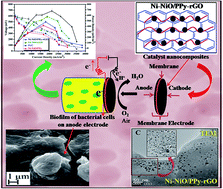Deposition of Ni–NiO nanoparticles on the reduced graphene oxide filled polypyrrole: evaluation as cathode catalyst in microbial fuel cells†
Abstract
Herein, we fabricated the in situ polymerization of pyrrole (Py) on reduced graphene oxide (rGO), formulated as a nanocomposite support matrix for the deposition of nickel–nickel oxide (Ni–NiO) nanoparticles (NPs), as a cost-effective cathode catalyst for application in microbial fuel cells. In the presence of an oxidant, pyrrole (Py) monomers were electrostatically adsorbed over the negatively charged rGO sheet, where the π–π interactions among the Py monomers resulted in its polymerization as polypyrrole (PPy). The synergistic effects of components of the support matrix resulted in durable electrocatalytic activity for the ORR in the prepared Ni–NiO/PPy–rGO composite in neutral media. The prepared composites were characterized by Fourier transform infrared spectroscopy (FTIR), UV spectroscopy, Raman spectrometry (RAMAN), X-ray Diffraction (XRD), X-ray photoelectron spectroscopy (XPS), and the results confirmed the presence of Ni+ and Ni2+ ions in the synthesized nanocomposites. In addition, nickel–nickel oxide (Ni–NiO) nanoparticles (NPs) were homogeneously dispersed over this PPy–rGO sheet during their deposition through field-emission scanning electron microscopy (FE-SEM) and transmission electron microscopy (TEM). Also, the synthesized nanocomposites, i.e., Ni–NiO/PPy–rGO (70 : 30), were electrochemically analyzed using cyclic voltammetric (CV), chronoamperometric (CA) and impedance spectroscopic (EIS) techniques to highlight its stability and efficacy as a nanocatalyst. In comparison with the conventional Pt/C catalyst (reduction potential at 0.521 V with −0.204 mA current), the superior stability and electrocatalytic activities of Ni–NiO/PPy–rGO (reduction potential of 0.535 V at −0.235 mA current) were observed via CV in the enhanced oxygen reduction reaction (ORR). In the microbial fuel cell (MFC), the cost-effective Ni–NiO/PPy–rGO nanocatalyst exhibited a higher current density and power density of 2134.56 mA m−2 and ∼678.79 ± 34 mW m−2 in comparison to the commercial Pt/C catalyst (1788.2 mA m−2 and ∼481.02 ± 24 mW m−2). Thus, overall, the present study illustrates the preparation and characterization, efficacy and electro-active stability of Ni–NiO/PPy–rGO as a cost-effective nanohybrid catalyst in single chambered MFCs during the ORR.



 Please wait while we load your content...
Please wait while we load your content...